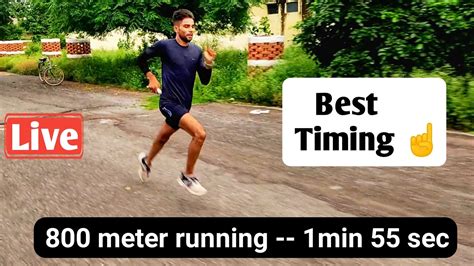The 800-meter run is a challenging but rewarding event that tests an athlete’s endurance, strength, and speed. Achieving a good time in the 800 meters requires a combination of dedicated training, strategic planning, and mental toughness.

Factors Influencing a Good Time
Several factors contribute to an athlete’s performance in the 800-meter run, including:
- Aerobic Capacity: The ability to efficiently use oxygen to sustain effort over a prolonged period.
- Lactic Capacity: The tolerance for lactic acid buildup, which causes fatigue during high-intensity exercise.
- Anaerobic Threshold: The point at which lactic acid begins to accumulate faster than it can be removed.
- Speed: The ability to accelerate quickly and maintain high speeds over the distance.
- Mental Fortitude: The perseverance, determination, and ability to push through discomfort.
Training Strategies
To improve these physical and mental attributes, athletes should adopt a comprehensive training program that includes:
1. Endurance Training:
- Regular long-distance runs (6-12 miles) to build aerobic capacity.
- Interval training (alternating high-intensity bursts with recovery periods) to increase lactic capacity and anaerobic threshold.
2. Speed Training:
- Sprint drills to improve acceleration and top-end speed.
- Hill workouts to develop leg strength and stride frequency.
3. Strength Training:
- Core exercises to stabilize the trunk and improve posture.
- Leg exercises (squats, lunges) to strengthen the muscles involved in running.
4. Rest and Recovery:
- Adequate sleep and nutrition to promote muscle repair and recovery.
- Cross-training activities to maintain fitness without overloading specific muscle groups.
Race Day Execution
On race day, athletes should focus on executing a well-calculated strategy:
1. Start: Explode out of the blocks and establish a strong initial pace.
2. Lap 1: Run slightly faster than race pace, gradually raising the effort level.
3. Lap 2: Settle into a sustainable race pace, maintaining a consistent rhythm.
4. Final 200 Meters: Accelerate progressively, delivering a powerful surge towards the finish line.
5. Breathing Techniques: Employ deep, diaphragmatic breathing to oxygenate the body effectively.
Benchmark Times
The following table provides benchmark times for the 800-meter run based on age and gender:
| Age Group | Gender | Good Time |
|---|---|---|
| 14-17 | Female | 2:20-2:35 |
| 14-17 | Male | 2:05-2:20 |
| 18-29 | Female | 2:10-2:25 |
| 18-29 | Male | 1:55-2:10 |
| 30-39 | Female | 2:15-2:30 |
| 30-39 | Male | 2:00-2:15 |
| 40+ | Female | 2:20-2:35 |
| 40+ | Male | 2:05-2:20 |
Elite Performances
The following table showcases world-record times and season’s best performances in the 800-meter run:
| Event | Record Holder | Time |
|---|---|---|
| World Record (Women) | Jarmila Kratochvílová | 1:53.28 |
| World Record (Men) | David Rudisha | 1:40.91 |
| Season’s Best (2023) (Women) | Athing Mu | 1:57.96 |
| Season’s Best (2023) (Men) | Emmanuel Korir | 1:43.23 |
Conclusion
Achieving a good time in the 800-meter run requires a balanced approach to training, race strategy, and mental toughness. By incorporating the principles and techniques outlined in this article, athletes can unlock their potential and strive for peak performance in this demanding event.
